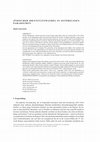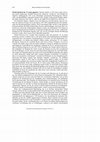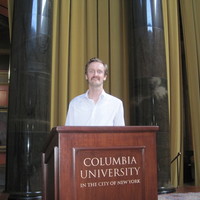Drafts by Ruth Leiserowitz
Some facts about the protagonists and processes how the Jewish minority contributed to the re-eme... more Some facts about the protagonists and processes how the Jewish minority contributed to the re-emergence of the Lithuanian state in 1918 with a special focus on selected events of the year 1919 in Paris.

The Second World War and the subsequent geopolitical transformation led to major migration proces... more The Second World War and the subsequent geopolitical transformation led to major migration processes. They touched most of the Eastern European territories and some of the border regions (in particular, the former Eastern Prussia territory), where the consequences of the shifting of political borders radically changed the structure of the population. When the local population (voluntarily or enforced) left their home, new citizens arrived to their places. These newly populated areas began to be formed in today's Poland, Lithuania as well as in Russia and Ukrainia and other border regions of Eastern Europe. The postwar situation of these territories and their further development shows many similarities and many differences. In some regions prewar local inhabitants played a role furthermore. But in other places, like todays Kaliningrad territory they were nearly wept out. The Klaipeda and the Kaliningrad region then parts of the Soviet Union, experienced certain flows of Russian-speaking people/population (mainly to the cities), and they became the territory of the Soviet Union. The geopolitical dependence of these territories was determined by the policy of their accommodation, colonization and ideological indoctrination. This policy shaped and changed the specific social and ethnic composition, the identity, the cultural and communal relations between the inhabitants of such territories. The workshop is dedicated to Eastern European regions, which, at the end of the Second World War, lost a part or most of the indigenous population, and where new societies were created and shaped during the postwar period. Some of these regions / territories have been extensively researched, others are still awaiting more detailed analysis (for example, the northernmost territory of the former Eastern Prussia, the Klaipeda region). We want to invite scholars to study Sovietisation especially in terms of border regions and migratory processes, to discuss the political system and aspects of the occupation regime-as the locals remaining in the regions affected by geopolitical transformation adapted to the postwar new society-and how the newcomers were integrated here. We like to discuss the following issues and questions:-What new national / ethnic groups went to these regions, why they moved to the new places and what kind of relationship(s) they developed to the locals.-How the postwar political ideological changes and the arising ideological conflicts between the past and the reality influenced the identity and communal relations of locals and foreigners.-How the old prewar and new postwar identities differed. Can we find processes of integration or separation of these identities? In which way is the influence of old or new ideological images into identities and the separation of communities reflected in family photographs?-Which aspects of cultural and communicative memory shaped the identity of the locals and the arrivers under the new geopolitical conditions of the postwar period?
Conference Presentations by Ruth Leiserowitz
CFP: New approaches to the history of the Suvalkija
CFP, 2019
Enclosed you find the call Minorities, Migration and Memory in East European Borderlands (1945-pr... more Enclosed you find the call Minorities, Migration and Memory in East European Borderlands (1945-present), 24 – 26 September 2019 in Warsaw, organized by the DFG/NCN – Project “Jews and Germans in Polish Collective Memory” at the Nordost Institut (IKGN e.V.) and the German Historical Institute Warsaw. Deadline: March 15, 2019
Papers by Ruth Leiserowitz

Jewish identity transformations in East Prussia: paradigms
Jewish immigration, which increased in East Prussia particularly after the Crimean War (1853-1856... more Jewish immigration, which increased in East Prussia particularly after the Crimean War (1853-1856) because of an immigration policy that had been liberal for decades, brought especially young Litvak families to the region. They came with the decided endeavour to leave a part of their Litvak traditions behind and to establish themselves in Prussia. Which Jewish identity did they pass on to their children, who grew up as citizens of the Reich? And how did the identity of the grandchildren's generation unfold? This very prominent change of identity is shown on the basis of one family that proves to be exemplary for Jews who immigrated in the second half of the 19th century. So I am reasoning from the following assumptions: first, the idea of Jūrgen Straubs that identity is always a formed construct which is based on knowledge, consciousness, and reflection; second, the assumption of Jan and Aleida Assmann, that identity can be seen as a practice of difference. The following contrib...

Lithuanian Historical Studies
This year, the city of Klaipėda celebrates the 770th anniversary of its founding, and in the run-... more This year, the city of Klaipėda celebrates the 770th anniversary of its founding, and in the run-up to these events, Vasilijus Safronovas has presented a comprehensive history of the city, already published in 2021, in a second edition. The author himself does not see his work as a scientific monograph, but rather as a guide to learning the history of the city, with its many facets. In a way, the undertaking presented several major challenges to a historian to write a history of the city. Firstly because its archives were lost at the end of the Second World War, and secondly because the history of the 20th century has many fractures and cannot be told in a simple linear fashion. In addition, there was no complete history of the city at all in postwar Klaipėda. The only comprehensive history of the city, written at the turn of the century by Johannes Sembritzki, a pharmacist and amateur historian, first appeared in Lithuanian in 2002. Of course, by then it was already long outdated. From these challenges, one can already sketch the starting points of the task that Safronovas faced when he set to work on reconstructing the history of his city. It was not a matter of simple reconstruction work. In recent decades, extensive research has been done on many individual aspects of the history of the city and the region (a long list of names could be mentioned here), and so a wide range of various important and highly interesting research results from all periods of the city's history is available. Many of them were produced by the staff and students of Klaipėda University, founded in 1991, and especially from its Institute of Baltic Region History and Archaeology. Safronovas, who is a graduate of the university and started his history career in the mentioned institute 20 years ago, has managed to find old chapters of history, to incorporate the new research results of his colleagues, and to combine all of them into convincing narratives with a fresh eye, leaving out no period in the city's history. In this respect, the author has elegantly mastered the challenges. So how did Safronovas manage the extensive material? In his introduction, he asks what is known about the city's past. He gives an
Rez. Ex: POLIN. Museum der Geschichte der polnischen Juden - HSK/ZOL / Rezensionen / Ausstellungen
Strukturen der Erinnerung
Heldenhafte Zeiten, 2017

Acta historica universitatis Klaipedensis, 2011
Jewish immigration, which increased in East Prussia particularly after the Crimean War (1853-1856... more Jewish immigration, which increased in East Prussia particularly after the Crimean War (1853-1856) because of an immigration policy that had been liberal for decades, brought especially young Litvak families to the region. They came with the decided endeavour to leave a part of their Litvak traditions behind and to establish themselves in Prussia. Which Jewish identity did they pass on to their children, who grew up as citizens of the Reich? And how did the identity of the grandchildren's' generation unfold? That very prominent change of identity is shown on the basis of one family that proves to be exemplary for Jews who immigrated in the second half of the 19th century. 6HYHUDO JHQHUDWLRQV FDQ EH GH¿QHG 7KH JHQHUDWLRQ RI WKH LPPLJUDQWV KDG FKLOGUHQ ZKR H[SOLFLWO\ IHOW German. The life of the grandchildren was connected to the decision for forced migration and thus with commitment to a new chosen homeland (in most cases, Palestine), in which the mental relationships to their home region were shaped in a very ambivalent way.
Chapter 5. Memel Territory
Berghahn Books, Dec 31, 2022

Family photos as a source of the history of the Memel territory
There are still to this day a large number of gaps in post-war Memel history in the Lithuanian SS... more There are still to this day a large number of gaps in post-war Memel history in the Lithuanian SSR due to the fact that the subject was neglected prior to 1989 for ideological reasons. Until then, the history of German minorities had remained taboo along with accounts of the mass emigration out of the USSR. As part of a survey and collection project, the Institute of Baltic History and Archaeology in Klaipėda collated private image sources that contain material relating to cultural and social spheres within the investigation period, with the aim of closing and discussing historiographical gaps. The photographs document private strategies that existed beneath the level of large-scale political decision-making. They provide insights into recreational past times, religious customs, private environments as well as relationships between genders and generations. A further theme highlighted by the collection is the mass emigration movement that took place from 1958 to 1960. In the second s...
Richard Butterwick, The Polish-Lithuanian Commonwealth, 1733–1795. Light and Flame. London, Yale University Press 2020
Historische Zeitschrift
Klaipėdos kraštas 1945-1960 m.: naujos visuomenės kūrimasis ir jo atspindžiai šeimų istorijose
Klaipėdos universiteto leidykla eBooks, 2019
Der Aufstieg der Memeler Holzhändler und die Familie Nafthal
Litblockín, 2007
Polen und Europa – Ein Fazit
Heldenhafte Zeiten, 2017
Wolfskinder in Sachsen
Sächsische Heimatblätter, Nov 15, 2021

Die baltischen Staaten, Ostpolen sowie die Bukowina und Bessarabien sind jene Gebiete des östlich... more Die baltischen Staaten, Ostpolen sowie die Bukowina und Bessarabien sind jene Gebiete des östlichen Europas, die in den Jahren 1939-1945 innerhalb kürzester Zeit nacheinander drei Besatzungsregimes erlebten. Diese Entwicklung fußte auf den in den geheimen Zusatzprotokollen des Hitler-Stalin-Paktes fixierten Entscheidungen, durch die diese Territorien als sowjetische Einflusssphäre definiert wurden. Im Frühsommer 1941 fanden in dieser Großregion nach der Flucht der sowjetischen Funktionäre und vor bzw. während des Einmarsches der Wehrmacht Pogrome statt, die von der jeweiligen lokalen Bevölkerung inszeniert wurden. Diese waren in ihrer Brutalität beispiellos. Witold M ę d y ko w s k i zeichnet diese Ereignisse nach und analysiert sie. In seiner Einleitung verweist er darauf, dass er sich diese große Untersuchungsregion mit Bedacht ausgesucht habe, da komplexe Forschungsfragen in Werken, die sich traditionellen Forschungsräumen, wie Staaten oder Ethnien, widmen, häufig "entwischen" (S. 16) würden. Mit diesem Ansatz hat M. zweifellos Recht, auch wenn er dieses Vorhaben, wie sich im Verlaufe der Lektüre zeigt, nicht zur Gänze einzulösen vermag. Er schildert im ersten Kapitel knapp die Vorgeschichte der Großregion zu Beginn des 20. Jh. und geht auch auf einige der früheren Pogrome ein, die 1881-1939 in Russland, der Ukraine und im Wilna-Gebiet stattfanden. Im Hauptteil der Arbeit werden die Pogrome im Juni 1941 exemplarisch für die Großregion von der Ostsee bis nach Bessarabien dargestellt. M. beschreibt detailliert einige der Übergriffe gegen die Juden in den unterschiedlichen Regionen und ergänzt sie durch zahlreiches, häufig auch bisher weniger bekanntes Fotomaterial. Er resümiert, dass es im sogenannten "Interregnum" zwischen den Diktaturen zu einer Degradierung der Juden kam und binnen weniger Tage "Brücken verbrannt" wurden bzw. der "Rubikon überschritten" wurde (S. 360). Dies ist zweifellos richtig. Selbst in Fällen, wo die Juden nicht sofort erschlagen oder erschossen wurden, hatten ihre nichtjüdischen Nachbarn in einer unbeschreibbaren Welle der Gewalt, die in vielem einem Affekt glichen, Situationen geschaffen, die sich nicht wieder rückgängig machen ließen. In zahlreichen kleinen Städtchen sperrte man die jüdische Bevölkerung tagelang in der Synagoge ein und raubte deren Wohnungen aus. Die unhaltbare Situation ließ sich aus Sicht der gewalttätigen Anführer schließlich nur durch die Liquidation der Juden lösen, auch wenn dies vorher nicht unbedingt intendiert worden war. Allerdings fallen M.s Erklärungen für die Ursachen recht allgemein aus. Er geht davon aus, dass hierfür maßgeblich das an vielen Orten im Frühsommer 1941 entstandene Machtvakuum schuld war und dass nach der Flucht der sowjetischen Funktionäre und vor dem Einmarsch der Wehrmacht und der Installation neuer Administrationen eine gefährliche Lücke geherrscht habe. Das Entstehen des Machtvakuums war tatsächlich eine wesentliche Voraussetzung für die blutigen Ereignisse. Jedoch beruhte es weniger auf äußeren als auf inneren Faktoren. M. sieht hier vor allem die lückenhaften Abläufe im Wechsel der Besatzungsmächte. Faktoren vor Ort, die sich im Vorfeld ereigneten und bereits zur Defragmentierung der lokalen Gesellschaften geführt hatten, werden von ihm nicht berücksichtigt. Diese sehr verallgemeinernde Begründung, der es an tieferem analytischem Gehalt mangelt, beruht auf der monoperspektivischen Betrachtungsweise der Großregion, die M. vor allem unter dem jüdischen Fokus sieht. Das von ihm untersuchte Gebiet zeichnete sich ursprünglich vor allem durch Multiethnizität aus. Eine erste Konsequenz der Geheimen Zusatzprotokolle des Spätsommers 1939 bestand in der Aussiedlung der deutschen Minderheiten aus den der UdSSR zugesprochenen Gebieten. Damit verschob sich das gesellschaftliche Gleichgewicht in den Kleinstädten, in denen Juden und Deutsche nebeneinander gelebt hatten, enorm. Gleichzeitig kam es zur Flucht von lokalen Repräsentanten der vorherigen Verwaltungen oder zu Verhaftungen, wodurch in den lokalen Gesellschaften











Uploads
Drafts by Ruth Leiserowitz
Conference Presentations by Ruth Leiserowitz
Papers by Ruth Leiserowitz